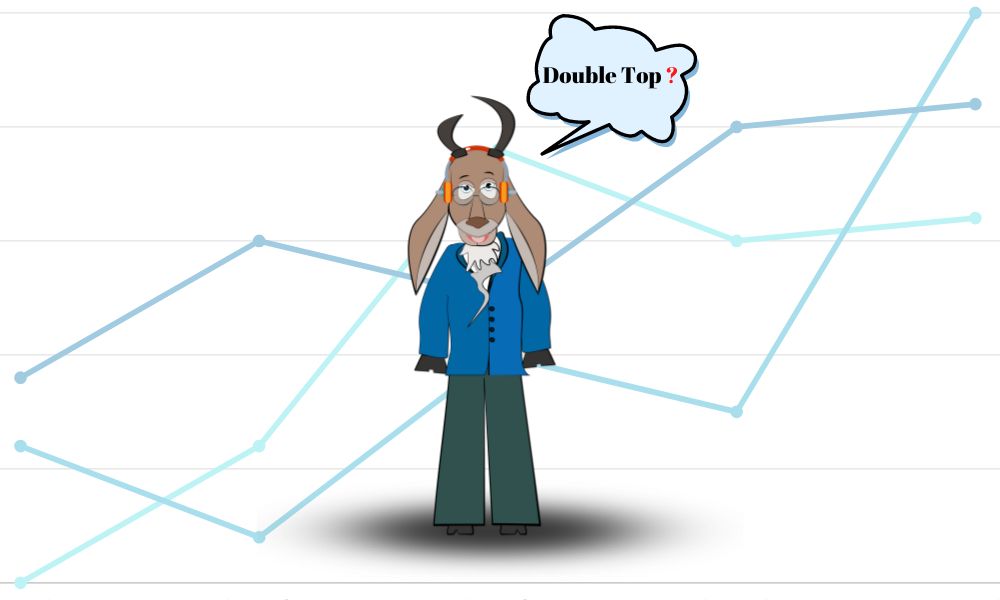
A change in an asset class' medium- to long-term trend might be indicated by the formation of a double top. The double top pattern that can be seen in the stock of Amazon.com, Inc. (AMZN) that formed between September and October of 2018 around a price of $2,050 is displayed in the chart that can be found above.
In this particular scenario, the level of support that built around $1,880 was significant. In spite of the fact that the stock dropped almost 8% from its peak in October to the support level at $1,880, one could not confirm the double top until after the stock fell below the $1,880 level.
After that moment, the price of the shares continued to fall, eventually reaching a level that was almost 31 percent lower.
In the following illustration, we will be using Netflix Inc. (NFLX), and in March and April of 2018, we can observe what appears to be the formation of a double top. In contrast, we can see that support is not breached in this instance, and it is not even tested, as the stock price continues to grow in accordance with an uptrend.
On the other hand, if one scrolls farther down the chart, they will notice that the stock appears to create what looks like a double top in the months of June and July. However, this time the pattern does turn out to be a reversal pattern, as evidenced by the price dropping below the support level of $380, which ultimately led to a drop of 39% to $231 in December.
Also, take note of how the support level located at $380 worked as a barrier to the stock's upward movement on two separate occasions in the month of November.
There is, in point of fact, a fundamental distinction to be made between a double top and an attempt that was unsuccessful.
A true double top is a very negative technical pattern that can lead to a very sharp decrease in the price of a stock or asset. This type of decline can be exceedingly catastrophic.
However, in order to prove the identity of a double top, it is very necessary to exercise patience and locate the important support level.
If you determine a double top based purely on the emergence of two successive peaks, you run the risk of receiving an inaccurate reading, which could prompt you to abandon a position too soon.
Once the correct identification has been made, double top formations are extremely useful. However, if they are understood in the wrong way, they have the potential to cause a great deal of harm. Before drawing any conclusions, one must, as a result, exercise a great deal of caution and patience.
After an asset has reached a high price two times in a row with a small decrease in price in between the two highs, a double top has formed, which is a very negative technical reversal pattern. Double tops are quite common in the financial markets.
It is validated when the price of the asset drops below a support level that is equivalent to the low that occurred in between the two prior highs.
A change in an asset class' medium- to long-term trend might be indicated by the formation of a double top. The double top pattern that can be seen in the stock of Amazon.com, Inc. (AMZN) that formed between September and October of 2018 around a price of $2,050 is displayed in the chart that can be found above.
In this particular scenario, the level of support that built around $1,880 was significant. In spite of the fact that the stock dropped almost 8% from its peak in October to the support level at $1,880, one could not confirm the double top until after the stock fell below the $1,880 level.
After that moment, the price of the shares continued to fall, eventually reaching a level that was almost 31 percent lower.
In the following illustration, we will be using Netflix Inc. (NFLX), and in March and April of 2018, we can observe what appears to be the formation of a double top. In contrast, we can see that support is not breached in this instance, and it is not even tested, as the stock price continues to grow in accordance with an uptrend.
On the other hand, if one scrolls farther down the chart, they will notice that the stock appears to create what looks like a double top in the months of June and July. However, this time the pattern does turn out to be a reversal pattern, as evidenced by the price dropping below the support level of $380, which ultimately led to a drop of 39% to $231 in December.
Also, take note of how the support level located at $380 worked as a barrier to the stock's upward movement on two separate occasions in the month of November.
There is, in point of fact, a fundamental distinction to be made between a double top and an attempt that was unsuccessful.
A true double top is a very negative technical pattern that can lead to a very sharp decrease in the price of a stock or asset. This type of decline can be exceedingly catastrophic.
However, in order to prove the identity of a double top, it is very necessary to exercise patience and locate the important support level.
If you determine a double top based purely on the emergence of two successive peaks, you run the risk of receiving an inaccurate reading, which could prompt you to abandon a position too soon.
Once the correct identification has been made, double top formations are extremely useful. However, if they are understood in the wrong way, they have the potential to cause a great deal of harm. Before drawing any conclusions, one must, as a result, exercise a great deal of caution and patience.